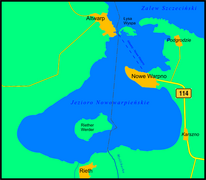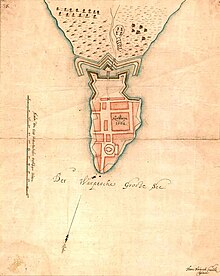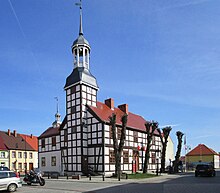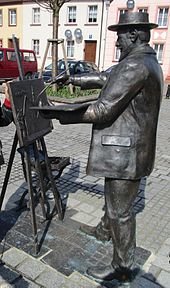Nowe Warpno
| Nowe Warpno | ||
|---|---|---|
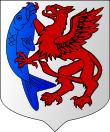
|
|
|
| Basic data | ||
| State : | Poland | |
| Voivodeship : | West Pomerania | |
| Powiat : | Policy | |
| Gmina : | Nowe Warpno | |
| Area : | 24.56 km² | |
| Geographic location : | 53 ° 44 ' N , 14 ° 17' E | |
| Height : | 1 m npm | |
| Residents : | 1190 (June 30, 2019) | |
| Postal code : | 72-022 | |
| Telephone code : | (+48) 91 | |
| License plate : | ZPL | |
| Economy and Transport | ||
| Street : | Ext. 114 : Tanowo- Nowe Warpno | |
| Ext. 115 : Stettin- Nowe Warpno | ||
| Rail route : | PKP line 406: Szczecin ↔ Trzebież , train station: Trzebież Szczeciński | |
| Next international airport : | Szczecin-Goleniów | |
| Administration (as of 2013) | ||
| Mayor : | Wladyslaw Kiraga | |
| Address: | pl. Zwycięstwa 1 72-022 Nowe Warpno |
|
| Website : | www.nowewarpno.pl | |
Nowe Warpno (Neuwarp) is a town and seat of the eponymous urban and rural municipality Nowe Warpno in the powiat Policki of the Polish West Pomeranian Voivodeship .
Geographical location
Nowe Warpno is located in the former eastern Western Pomerania 46 kilometers northwest of Stettin ( Szczecin ) and 30 kilometers northwest of the district town of Police ( Pölitz ) on the state border with Germany on a peninsula between Lake Neuwarper and the Stettiner Haff . The closest border crossing to Germany is 14 kilometers away and is at Hintersee, which is 4 kilometers away from the border.
City structure
The following villages that were independent until 1945 and are now part of the municipality belong to the urban area of Nowe Warpno:
- Grądno ( Garden )
- Karszno ( Albrechtsdorf )
- Małachowo
- Miroszewo ( Steinort )
- Podgrodzie ( old town )
- Przedborze ( Luisenruh )
- Rytka ( Riether Mill )
Albrechtsdorf Castle in the Karszno district
history
A documented mention of Warpene from 1184 is doubtful, it could also mean Altwarp . The exact date of the award as a city is not known. It is believed that in the mid-13th century Duke I. Barnim was that the place with Magdeburg Law occupied. Before that there was probably a castle on the site of the old town to the north. When Pomerania was divided in 1295, the town of Warp became part of Pomerania-Stettin. The name Neuwarp can be found for the first time in 1352 with civitas Nova Warpe , as Barnim III. lent his income from the town to the Stettiner Otto Foundation. In 1378 the church in Neuwarp was subordinated to the Jasenitz monastery.
The development of Neuwarp into a flourishing port town that was free of customs duties in the entire Duchy of Pomerania-Stettin aroused the resentment of the city of Stettin, which hindered shipping, whereupon Duke Otto I gave the city permission to take countermeasures. In 1442 Neuwarp received privileges under Luebian law from Duke Joachim I. After the devastating fire of 1491, which completely destroyed Neuwarp with the church and town hall and in which all documents were lost, the ducal house confirmed all rights of the city in 1491. In 1555 another fire broke out, which left the city to rubble and ashes. Duke Philip I renewed the Neuwarper privileges in 1556 and again granted the city the more favorable Luebian law . In 1559 Neuwarp owned two hospitals (Hospital zum St. Georg, Hospital zum Heiligen Leichnam). In 1648 Neuwarp fell to Sweden. The third big city fire broke out in 1692.
After the reconstruction, the Neuwarper had to endure billeting of Russian, Saxon and Polish troops in the Great Northern War from 1710, which also brought the plague into the city. Trade and industry declined. After the Treaty of Stockholm in 1720, the city became part of Prussia. When many citizens fought in the ranks of the Schill Freischar during the Wars of Liberation against Napoleon , the French occupiers threatened to have the city burned down. In return for a fine of 1,000 thalers, the French showed themselves "gracious" and only burned down one house.
Since 1818 the city belonged to the district of Ueckermünde . In the course of the 19th century Neuwarp fell into insignificance as a trading town. Because of the more favorable location of the neighboring cities of Pölitz , Stettin , Swinoujscie and Wollin , maritime trade on the Stettiner Haff was more and more bypassing Neuwarp. The location at the tip of a headland was also not conducive to the craft because the city lacked the surrounding area.
In 1862 many craftsmen were recorded, including a. 23 shoemakers. But the main source of income was shipping; there were 9 seamen and 89 barge and boat drivers in Neuwarp. Another main occupation was fishing, Neuwarp had 30 master fishermen and 18 journeymen.
At the beginning of the 20th century Neuwarp developed into a well-known climatic health resort.
After the end of the Second World War , the city became part of Poland and renamed Nowe Warpno . Almost the entire German population was expelled or forcibly resettled in the period that followed .
- History of the parish
In 1267 the church at "Warpa" appeared under the possessions of the Grobe monastery . In 1286 the Provost of St. Mary in Stettin was given jurisdiction over the Church of Warp. In 1378 the church patronage was transferred to the Jasenitz monastery .
After 1535, the Reformation also took hold in Neuwarp. Since then, a total of 20 Lutheran clergymen have officiated here until 1945, plus 21 deacons, who also looked after the branch church in Altwarp until 1898, when it got its own clergy.
Before 1945 the parish of Neuwarp with the subsidiary communities Wahrlang (now Polish: Warnołęka ) and Albrechtshof ( Karszno ) belonged to the parish of Ueckermünde in the church province of Pomerania of the Church of the Old Prussian Union . The church patronage was most recently exercised by the state authorities and Ms. von Enckevort from Albrechtsdorf. In 1940 the parish of Neuwarp had 2,730 parishioners.
Since 1945 the population of Neuwarp has been predominantly Catholic . A parish was established in the city on August 15, 1946, which today belongs to the Police Dean's Office ( Pölitz ) in the Archdiocese of Stettin-Cammin . The branches Warnołęka ( Wahrlang ), Podgrodzie ( old town ) and Myśliborz Wielki ( Groß Mützelburg ) are integrated into the parish . Evangelical church members living in Neuwarp and the surrounding area are assigned to the parish office of the Evangelical Lutheran Trinity Church ( St. Gertrudenkirche before 1945 ) in the diocese of Wroclaw of the Evangelical Augsburg Church in Poland .
Development of the population
| year | population |
| 1740 | 990 |
| 1774 | 1,260, not Jews |
| 1779 | 1,084 |
| 1782 | 1,181, no Jews |
| 1791 | 949, no Jews |
| 1794 | 1,260, not Jews |
| 1812 | 1,457, including three Jews, no Catholics |
| 1816 | 1,412, including two Catholics and two Jews |
| 1831 | 1,600, including eight Catholics and three (nine) Jews |
| 1843 | 1,821, thereof 13 Catholics and 14 Jews |
| 1852 | 2,017, including ten Catholics and twelve Jews |
| 1858 | 1,969, including 16 Catholics and ten Jews |
| 1861 | 2,125, including 14 Catholics and 12 Jews |
| 1905 | 1,883 |
| 1925 | 2,007, including six Catholics and five Jews |
| 1933 | 2.010 |
| 1939 | 2,055 |
| 2008 | 1,194 |
Attractions
Marienkirche
St. Mary's Church, Protestant until 1945, is a late Gothic brick building with a choir and tower. It was probably built in 1442. The beam ceiling, which was once painted in color, was painted over. After the devastating fire in 1692, the church was rebuilt a year later and equipped with a baroque altar with a crucifixion group between winding columns.
After the Second World War , the church was taken over by the Catholic Church in Poland , which rededicated it on August 15, 1946 (the day of the Assumption of Mary ). Since then, the church has been called the Church of the Assumption .
- More Attractions
- Town hall, baroque half-timbered building from 1697
- Waterfront promenade with a modern viewing platform
- Marina east of the port
- Newly built, modern campsite with a marina in the southeast of the city on Lake Neuwarper
- redeveloped old town with newly designed squares and paths
- Life-size bronze memorial figure of the German honorary citizen Hans Hartig on the town hall square
Economy and Infrastructure
Companies
The economy is poorly developed in this remote area. Small commercial enterprises, agriculture and forestry as well as the tourism industry determine the structure. Only the district town, 30 kilometers away, has a major employer for the region with the former Pölitz hydrogenation plant.
The newly designed campsite with a marina on the lake side, together with the older marina on the lagoon side, gives the community a new look in the direction of economically important tourism.
traffic
The city can be reached via Voivodship Road 114 via Police ( Pölitz ). A connecting road near the border leads from 114 to Voiwodschaftsstrasse 115 , which is continued on German territory as L 28 at the border.
There is a rail connection via Trzebież ( goat town ), 16 kilometers away . From 1906 to 1945 Neuwarp was the terminus of the Randower Bahn , which ran from Stöven ( Stobno ) via Daber ( Dobra ), Hintersee and Rieth here. When the border was drawn in 1945, the line was interrupted and later dismantled on both sides.
Between 1996 and 2010 there was a passenger ferry connection between Nowe Warpno and the neighboring German municipality of Altwarp . Now, despite the modern border crossings with the ferry port, the connection is only served seasonally by the former cutter Lütt Matten .
Town twinning
- Ueckermünde , Germany (1993-2015)
Personalities
Sons and daughters of the place
- Ernst Mentzel (1878–1960), German politician (DNVP), member of the German Reichstag
- Heinz-Dietrich Ortlieb (1910–2001), German economist, head of the Hamburg World Economic Archives
Honorary citizen
- In 1927 the city of Neuwarp made the painter and graphic artist Hans Hartig (1873–1936) an honorary citizen. Like other artists, Hartig liked to visit the place because of its remote location to work and also to relax and was very connected to the city. The Polish city administration honored him with the life-size bronze monument erected in front of the town hall, because he was not only connected to the site as a visitor and painter, but also played a key role in the restoration and design of the medieval town hall, as the plaque on the monument says.
literature
- Johannes Hinz: Pomerania. Signpost through an unforgettable country. Bechtermünz, Augsburg 1996, ISBN 3-86047-181-3 .
- Hans Moderow : The Protestant clergy of Pomerania from the Reformation to the present , Part I: The administrative district of Stettin . Szczecin 1903.
- Gustav Kratz : The cities of the province of Pomerania - an outline of their history, mostly according to documents . Sendet Reprint Verlag, Vaduz 1996 (unchanged reprint of the 1865 edition), ISBN 3-253-02734-1 , pp. 275-278 .
- Heinrich Berghaus : Land book of the Duchy of Pomerania and the Principality of Rügen . Part II, Volume 1: The districts of Demmin, Anklam, Usedom-Wollin and Ückermünde , Anklam 1868, pp. 939 ff. And 951 ff.
Web links
See also
Individual evidence
- ↑ population. Size and Structure by Territorial Division. As of June 30, 2019. Główny Urząd Statystyczny (GUS) (PDF files; 0.99 MiB), accessed December 24, 2019 .
- ↑ a b c d e f g h i Heinrich Berghaus : Land book of the Duchy of Pomerania and the Principality of Rügen. Part II, Volume 1: The districts of Demmin, Anklam, Usedom-Wollin and Ückermünde , Anklam 1868, p. 939 ff. And p. 951 ff.
- ↑ a b c d e f g Gustav Kratz : The cities of the province of Pomerania - outline of their history, mostly according to documents . Sendet Reprint Verlag, Vaduz 1996 (unchanged reprint of the 1865 edition), ISBN 3-253-02734-1 , p . 277 .
- ↑ a b c d e f Heinrich Berghaus : Land book of the Duchy of Pomerania and the Principality of Rügen . Part II, Volume 1: The districts of Demmin, Anklam, Usedom-Wollin and Ückermünde . Anklam 1868, p. 940.
- ↑ Christian Friedrich Wutstrack : Short historical-geographical-statistical description of the royal-Prussian duchy of Western and Western Pomerania . Stettin 1793, p. 1791.
- ↑ Gunthard Stübs and Pomeranian Research Association: The town of Neuwarp in the former Ueckermünde district in Pomerania (2011)
- ^ A b Michael Rademacher: German administrative history from the unification of the empire in 1871 to the reunification in 1990. Ueckermünde district (Ukermünde). (Online material for the dissertation, Osnabrück 2006).
- ^ Website of the Altwarp municipality, Hafen , accessed on July 28, 2010
- ↑ Partnership ties. City of Ueckermünde, accessed on April 7, 2019 .

